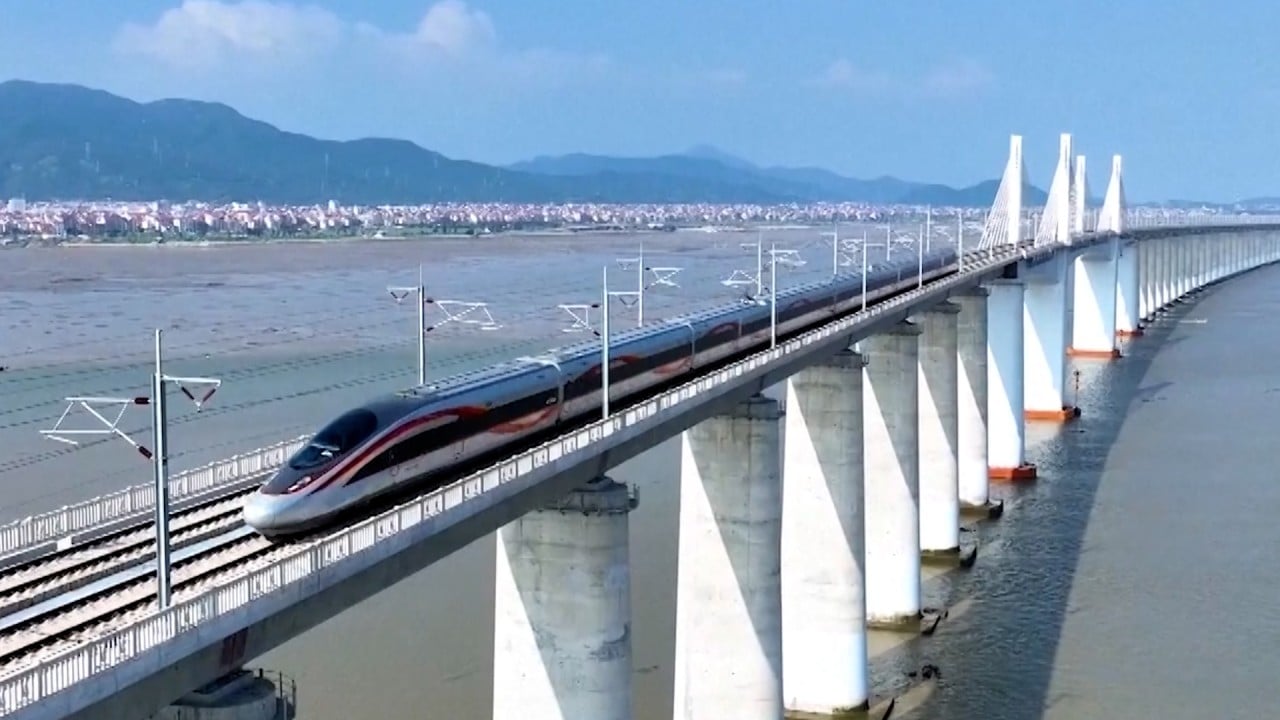
China puts trust in AI to maintain largest high-speed rail network on Earth
- The railway system is in better condition than when it was first built, according to peer-reviewed paper
- Vast amounts of real-time data are processed by an artificial intelligence system in Beijing to identify problems before they arise, the engineers say
An AI system in Beijing is processing vast amounts of real-time data from across the country and can alert maintenance teams of abnormal situations within 40 minutes, with an accuracy as high as 95 per cent, they said in a peer-reviewed paper.
“This helps on-site teams conduct reinspections and repairs as quickly as possible,” wrote Niu Daoan, a senior engineer at the China State Railway Group’s infrastructure inspection centre, in the paper published by the academic journal China Railway.
In the past year, none of China’s operational high-speed railway lines received a single warning that required speed reduction due to major track irregularity issues, while the number of minor track faults decreased by 80 per cent compared to the previous year.
According to the paper, the amplitude of rail movement caused by strong winds also decreased – even on massive valley-spanning bridges – with the application of AI technology.
Machine intelligence can predict and issue warnings before problems arise, enabling precise and timely maintenance that keeps the infrastructure of high-speed rail lines in better condition than when it was first built, according to the researchers.
Niu and his team said the significant amount of data generated by the sensors embedded in high-speed rail infrastructure was “forcing China to adopt new technologies such as big data and artificial intelligence”.
The adoption of these technologies allowed for “more precise and timely assessments and scientific evaluations of infrastructure service status”, they said.
According to the paper, after years of effort Chinese railway scientists and engineers have “solved challenges” in comprehensive risk perception, equipment evaluation, and precise trend predictions in engineering, power supply and telecommunications.
The result was “scientific support for achieving proactive safety prevention and precise infrastructure maintenance for high-speed railways”, the engineers said.
Before construction began on China’s first high-speed rail line 15 years ago, critics argued that maintenance would become an unbearable burden as wires and rails inevitably aged.
By the end of last year, the network surpassed the length of the equator, posing an engineering and technological challenge to maintain its safe operation.
Across the Pacific, the ageing US railway network is facing the same issue, with lack of maintenance leading to frequent safety incidents. In the past 50 years, the average number of derailments has exceeded 2,800 per year, peaking at nearly 10,000 in 1978.
China’s high-speed rail is the fastest in the world, operating at 350km/h (217mph), with plans for an increase next year to 400km/hr (249mph). The network is expected to continue its rapid expansion until it connects all cities with populations over 500,000.
But Niu’s team identified a looming problem for the rail network, in the combination of rising incomes, a declining birth rate and the overall ageing of the population – the number of maintenance workers will gradually decrease compared to present levels.
China’s middle-income population passes 500 million mark: state-run newspaper
The engineers said the emergence of AI as an opportunity for high-speed rail health management was recognised more than a decade ago, in countries like Germany and Switzerland.
Both European countries proposed plans to improve rail maintenance using machine intelligence, but their railway networks were small in comparison to that in China, the team pointed out.
To meet the need for extensive real-world data to train the AI system, Chinese railway scientists and engineers collected and organised nearly 200 terabytes of raw data for AI – more than 10 times the entire data volume of the US Library of Congress.
The data comes from various sources and formats, including dynamic waveform values captured by wheel sensors, records of train body movements, rail vibrations, and meteorological records.
According to the paper, fluctuations in power grid current amplitudes – and even electromagnetic spectrum monitoring records – have been used to train the system.
AI’s advantage lies in its ability to analyse diverse data, identify potential problem-related clues and uncover previously unknown connections within seemingly chaotic data sets. This enables more precise fault identification and prediction.
Niu’s team said the technology had improved the efficiency of new data analysis by 85 per cent. Previously, the maintenance management headquarters in Beijing was able to issue nationwide warnings once a week. Regular reports are now issued daily.
According to the paper, the China State Railway Group implemented a data management protocol in 2022, imposing numerous restrictions on data storage, usage, and other privileges to make sure the system remains under control.
The AI algorithms underwent rigorous human review to ensure their safety before being included in the toolbox, the engineers said.
While the AI technology gap between China and the US appears to be widening, some observers suggest it is actually narrowing and that there may be Chinese breakthroughs in certain critical areas using smaller, specialised models.
US government sanctions are preventing China from accessing the most advanced AI chips, slowing its development of large models – like OpenAI’s Sora and its realistic simulations of the physical world.
But self-driving cars equipped with high-performance lidar sensors are becoming increasingly affordable and popular in China, where AI has also taken the lead in weather forecasting systems.
Automated port terminals have significantly improved logistics efficiency and intelligent ultra-high-voltage power grids are sending wind and solar energy from the Gobi Desert to distant regions across the country.
A scientist working in AI applied research in Beijing, who asked not to be named, said the emergence of large models like ChatGPT and Sora was “a pleasant surprise”.
“If the US can translate this technology into tangible productivity, it has the potential to maintain its leadership position in the world. Otherwise the leadership will be an illusion.”





